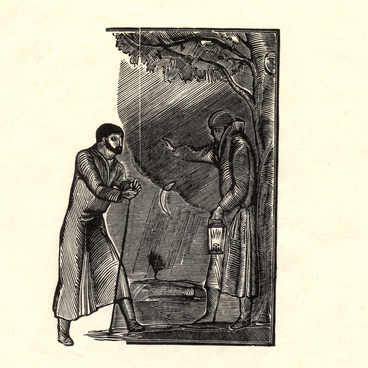After the Kazan Cathedral was ruined in Konstantinovo, the icon came into possession of Sergei Esenin’s fellow villagers. The museum acquired it in 1982.
As we read in The Orthodox Encyclopaedia, “The icon represents the Mother of God, full-size, with baby Jesus in her arms. A blessed radiance surrounds her figure. This image goes back to the Book of Revelation of John the Evangelist: “A great and wondrous sign appeared in heaven: a woman clothed with the sun, with the moon under her feet and a crown of twelve stars on her head. She gave birth to a son, a male child, who will rule all the nations with an iron sceptre. And her child was snatched up to God and to his throne.”
A prototype of this icon was created in Germany in the 15th century and became well-known in the Occidental art. In the 17th century, similar images made their way from Poland to Russia via Ukraine, Belarus, and Lithuania.
In Anthropological Poetics of Sergei Esenin, folklore expert Elena Samodelova writes: As Voronova, a modern philologist, notes, “Esenin”s true spiritual discovery was the poetic image of baby Christ… A child”s purity and fragility have always been perceived by the Russian literary tradition as a manifestation of the ideal principles of human nature. Baby Jesus, the Divine Infant, was, as it were, the ultimate, reinforced expression of this idea, repeatedly sanctified in the archetypal themes of icons of the Mother of God, especially revered by people. In 1914, Esenin”s small poem Us (The Moustache) presented, for the first time, a complex juxtaposition of two characters: an earthly man and God-Man, who simultaneously coexist in two ages – a child and an adult.”’
Sergei Esenin often mentions the Mother of God in his work. For example, his poem Ne vetry osypayut pushchi (It’s not winds that make forests shed leaves) reads:
I see that in a bluish gown,
Beloved Virgin Mary comes,
Off white-winged clouds, she steps down,
With Baby Jesus in her arms.
And she hugs her little child,
Who’ll be murdered on a cross:
‘Walk, my son, live in the wild,
Watch the dawns from hills of moss.’
Meeting any wretched fraud,
I will try to learn, homesick,
Whether he was blessed by God,
As he grips his birch tree stick.
And perhaps I’ll just pass by,
But a cherub, cute and plump,
Will sing a pretty lullaby
To a hungry Jesus under a stump.
As we read in The Orthodox Encyclopaedia, “The icon represents the Mother of God, full-size, with baby Jesus in her arms. A blessed radiance surrounds her figure. This image goes back to the Book of Revelation of John the Evangelist: “A great and wondrous sign appeared in heaven: a woman clothed with the sun, with the moon under her feet and a crown of twelve stars on her head. She gave birth to a son, a male child, who will rule all the nations with an iron sceptre. And her child was snatched up to God and to his throne.”
A prototype of this icon was created in Germany in the 15th century and became well-known in the Occidental art. In the 17th century, similar images made their way from Poland to Russia via Ukraine, Belarus, and Lithuania.
In Anthropological Poetics of Sergei Esenin, folklore expert Elena Samodelova writes: As Voronova, a modern philologist, notes, “Esenin”s true spiritual discovery was the poetic image of baby Christ… A child”s purity and fragility have always been perceived by the Russian literary tradition as a manifestation of the ideal principles of human nature. Baby Jesus, the Divine Infant, was, as it were, the ultimate, reinforced expression of this idea, repeatedly sanctified in the archetypal themes of icons of the Mother of God, especially revered by people. In 1914, Esenin”s small poem Us (The Moustache) presented, for the first time, a complex juxtaposition of two characters: an earthly man and God-Man, who simultaneously coexist in two ages – a child and an adult.”’
Sergei Esenin often mentions the Mother of God in his work. For example, his poem Ne vetry osypayut pushchi (It’s not winds that make forests shed leaves) reads:
I see that in a bluish gown,
Beloved Virgin Mary comes,
Off white-winged clouds, she steps down,
With Baby Jesus in her arms.
And she hugs her little child,
Who’ll be murdered on a cross:
‘Walk, my son, live in the wild,
Watch the dawns from hills of moss.’
Meeting any wretched fraud,
I will try to learn, homesick,
Whether he was blessed by God,
As he grips his birch tree stick.
And perhaps I’ll just pass by,
But a cherub, cute and plump,
Will sing a pretty lullaby
To a hungry Jesus under a stump.



